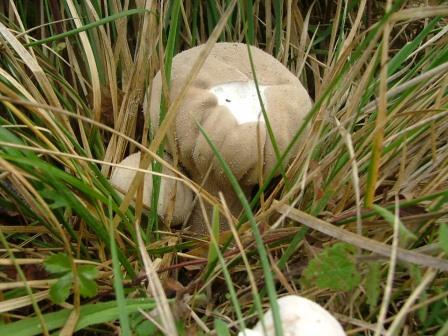Pestle puffball
One of many puffballs of the extensive grassland areas of the New Forest, the Pestle Puffball (Lycoperdon exipuliforme) is probably the most often noticed, because it is tall, white, impressive, and is common and widespread.
The brown spores of Puffballs mature inside the ball and are then liberated in various ways, often when the entire fruiting body disintegrates so the powdery spore mass can dispersed by the wind. When mature, they can even be squeezed by hand which will make the dry brown spores fly out into the air. Quite fun and satisfying to do!
White or light buff coloured, usually maturing to various shades of brown, Puffballs may range in size from 6cm to 70cm across and up to 20cm tall, with or without a short stem. They grow singularly or in groups, or just spread out over a large area, and they may even form fairy rings. They are most easily seen in the late summer to early autumn and are widespread and common on grassy places.
Two small round species of Puffballs even detach themselves from the ground to blow around in the wind, and thus distribute their spores, which they are only able to do on the short well grazed grassland of the New Forest. At the other end of the scale, another species can grow to a huge size and may reach a record weight of over 10kg.
As late as the 19th century, unripe Puffballs were often used as a surgical dressing for wound staunching by surgeons and even as an anaesthetic, and bee keepers used them to calm bees. A bee keeper would put a smouldering pile of puffballs underneath the hive to enable them to gain access without being stung. No doubt it was probably the high level of carbon dioxide that calmed the insects! It is even recently suspected that Puffballs were involved in making and transporting fire and also being used as a form of insulation and draught excluder.


